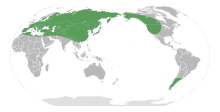Androsace
| Androsace | |
|---|---|
| | |
| Androsace laevigata in Olympic National Park, United States | |
| Scientific classification | |
| Kingdom: | Plantae |
| (unranked): | Angiosperms |
| (unranked): | Eudicots |
| (unranked): | Asterids |
| Order: | Ericales |
| Family: | Primulaceae |
| Genus: | Androsace L. |
| Sections | |
|
Andraspis
Aizoidium
| |
 | |
Androsace is a genus in the family Primulaceae, second only to Primula in number of species.[2] It is a predominantly Arctic–alpine genus with many species in the Himalayas (where the genus originated), the mountains of central Asia, the Caucasus, and the southern and central European mountain systems, particularly the Alps and the Pyrenees.
Recent molecular studies show that the genera Douglasia (found in north-western North America and easternmost Siberia), Pomatosace (an Himalayan endemic) and Vitaliana (a European endemic) belong within Androsace.[2][3] Phylogenetic studies have also demonstrated that the ancestor of Androsace first appeared about 35 Mya ago and was most probably an annual species.[4] Evolution towards the denser morphology of cushions took place two times independently in Asia and in Europe.[4]
Plants of this genus are sometimes known as rock jasmines or fairy candelabras and are widely cultivated for their dense cushions covered in white or pink flowers. There are about 110 species.[5][6]
Species include:
- Androsace affinis
- Androsace adenocephala
- Androsace aizoon
- Androsace alaschanica
- Androsace albana
- Androsace alpina
- Androsace axillaris
- Androsace baltistanica
- Androsace brachystegia
- Androsace brevis
- Androsace cantabrica
- Androsace carnea
- Androsace chamaejasme
- Androsace chaixii
- Androsace ciliata
- Androsace cylindrica
- Androsace elatior
- Androsace elongata
- Androsace erecta
- Androsace filicula
- Androsace filiformis
- Androsace gagnepaianna
- Androsace halleri
- Androsace hausmannii
- Androsace hedraeantha
- Androsace henryi
- Androsace helvetica
- Androsace komovensis
- Androsace koso-poljanski
- Androsace lactea
- Androsace laevigata
- Androsace laggeri
- Androsace lehmanniana
- Androsace mairei
- Androsace mariae
- Androsace mathildae
- Androsace maxima
- Androsace minor
- Androsace obtusifolia
- Androsace occidentalis
- Androsace paxiana
- Androsace pubescens
- Androsace pyrenaica
- Androsace raddeana
- Androsace rigida
- Androsace rioxana
- Androsace sarmentosa
- Androsace septentrionalis
- Androsace sempervivoides
- Androsace stenophylla
- Androsace spinulifera
- Androsace squarosulla
- Androsace tapete
- Androsace tanggulashanensis
- Androsace triflora
- Androsace umbellata
- Androsace vandellii
- Androsace villosa
- Androsace vitaliana
- Androsace wardii
- Androsace yargongensis
- Androsace zambalensis
References
- ↑ 1.0 1.1 1.2 Douglasia, Pomatosace, and Vitaliana were formerly treated as separate genera.
- ↑ 2.0 2.1 Gerald M. Schneeweiss, Peter Schönswetter, Sylvia Kelso & Harald Niklfeld (2004). "Complex biogeographic patterns in Androsace (Primulaceae) and related genera: evidence from phylogenetic analyses of nuclear internal transcribed spacer and plastid trnL-F sequences" (PDF). Systematic Biology 53 (6): 856–876. doi:10.1080/10635150490522566. JSTOR 4135374. PMID 15764556.
- ↑ Trift I., Anderberg A. A. and Källersjö M. 2002. The monophyly of Primula (Primulaceae) evaluated by analysis of sequences from the chloroplast gene rbcL. Systematic Botany 27(2):396-407
- ↑ 4.0 4.1 Florian C. Boucher, Wilfried Thuiller, Cristina Roquet, Rolland Douzet, Serge Aubert, Nadir Alvarez & Sébastien Lavergne (2012). "Reconstructing the origins of high-alpine niches and cushion life form in the genus Androsace s.l. (Primulaceae)" (PDF proof). Evolution 66 (4): 1255–1268. doi:10.1111/j.1558-5646.2011.01483.x.
- ↑ Jepson Manual Treatment
- ↑ Flora of China